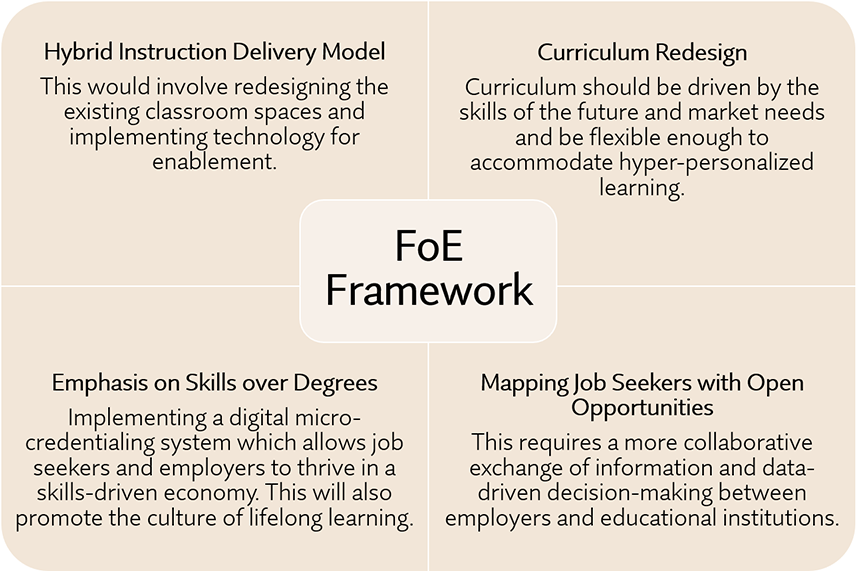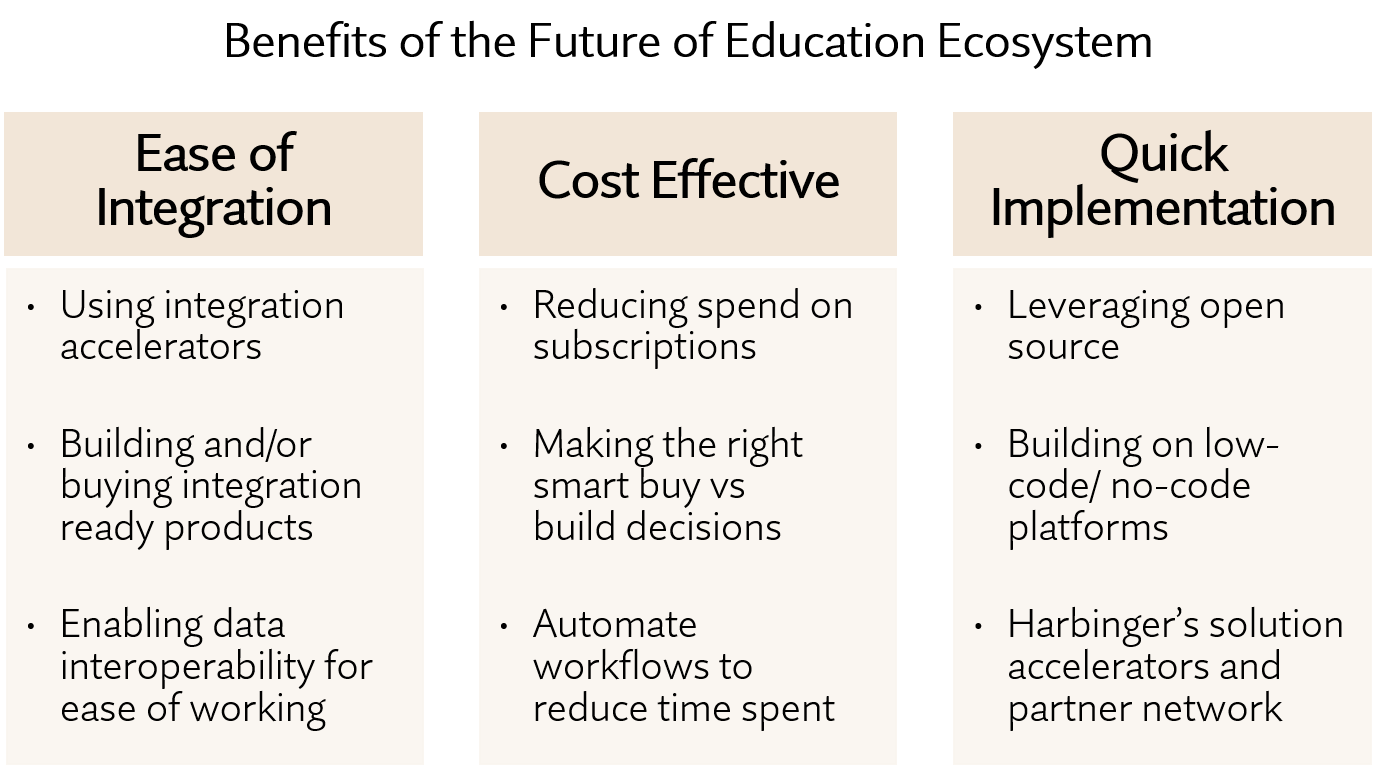
Education is highly influential in the process of change. And as the way we work and learn is changing at a rapid pace, it is time to take a closer look at the future of education framework and leverage its potential to think about education from a strategic perspective.
According to a report by McKinsey & Company, the United States of America requires more graduates to bridge the skilled jobs deficit, drive economic growth, improve health outcomes and civic engagement.
As we live in an era where automation and intangible value creation are at the forefront of growth, there is a massive shift in the skills needed to contribute to the economy and how people work.
Now the million-dollar question is, how can the current education system evolve to keep pace with these changes?
Considering the gravity of the problem, it is the need of the hour to look at the future of education on a serious note. And as we stand at the crossroads of traditional pedagogy and cutting-edge methodologies, having a framework in place can be a game changer.
What is the Future of Education Framework?
The overall idea behind strengthening the future of education is to create an integrated ecosystem of frameworks that have the potential to offer a clear direction for employment. It is a necessary phenomenon to bridge the gap between “education to employment.”
This means there is a dire need to train and educate the students of today with technical and soft skills. Likely to be introduced to an entirely new world of business models, educational institutions, colleges, and even corporates need to give education the right direction, which is possible by embracing a framework that is strategically built to be future-ready.
Watch our Power Hour ‘Future of Education: Connecting the Dots Between Education and Employment’ to get expert insights on the future of education ecosystem and its four key pillars. Explore top drivers of the future of education.
The future of education is about creating an integrated ecosystem of frameworks which lay out a clear pathway for employment. ‘Education to employment’ would be primarily driven by market needs, such as increasing unemployment rates, talent shortage across industries, skills required for the workplace of future, and openness to hire for skills vs degrees.
3 Benefits of the Future of Education Framework
1. Enhanced Relevance and Skill Development
The future of education framework is designed to prioritize the skill development that aligns with evolving industry demands. This helps ensure that students are trained to be in the workforce of the future, leading to better employability and career prospects.
2. Personalized Learning Experiences
Built on the principles of innovation and insights to reshape and nurture knowledge to empower learners for a better tomorrow, the future of education framework leverages technology to offer personalized learning experiences. Right from blending learning with gamification, nudges, quizzes, and more, it can foster more effective comprehension and retention of knowledge.
3. Global Accessibility and Inclusivity
The future of education framework focuses on digital platforms to make learning more accessible to individuals across the world, making learning more flexible.
4 Pillars of Harbinger’s Future of Education Framework

As the world of education and work changes rapidly, it is time to hit the reset button by making a strong and valid connection between education and employment. The future of education framework built by Harbinger is designed on similar principles. Let’s learn about the four pillars of this framework.
1. Hybrid Instruction Delivery Model
The hybrid instruction delivery model, also termed the blended learning model, is a revolution in the education spectrum. It is an educational approach that combines the traditional pedagogy of in-person instruction with online learning components. It seeks to make the most of both face-to-face interactions and the flexibility of online learning.
Interestingly, a hybrid instruction delivery model enables the participation of students in a combination format of on-campus classes and online activities. This particular format may vary from institution to institution.
Factors associated with a hybrid instruction delivery model:
- Face-to-face instruction
- Online learning
- Flexibility and self-paced learning
- Blended activities
- Assessment and feedback
2. Curriculum Redesign
As the needs and demands of society and the workforce evolve, it is essential to upgrade and update the curriculum to ensure that learners acquire knowledge, skills, and competencies to be ready for the future.
Additionally, the curriculum redesign should be such that it accommodates hyper-personalized learning that caters to the learners’ unique learning preferences, interests, and strengths.
Factors associated with curriculum redesign:
- Future-oriented skills
- Integration of technology
- Interdisciplinary and project-based learning
- Personalized and learner-centric approach
3. Emphasis on Skills Over Degrees
The concept of skills over degrees has gained traction recently as individuals and employers understand the importance of practical abilities and specific skills for the ever-evolving market. One of the emerging trends in this area is micro-credentials, as they offer a more effective way to broaden a skill set and stay in sync with applicable and emerging practices.
Micro-credentials are often offered by educational institutions, professional organizations, or online learning platforms, which require less time and investment than traditional degrees.
Factors associated with skills over degrees:
- Specific skill validation
- Flexible learning options
- Industry relevance
- Lifelong learning
4. Mapping Job Seekers with Open Opportunities
Mapping job seekers with open opportunities is the need of the hour. It is a concept that strengthens the future of education as it aligns skills with available options. This is an essential pillar of the future of education framework as it works toward bridging the gap between education and employment by creating a more streamlined, effective process for connecting individuals with the right job opportunities.
Factors associated with mapping job seekers with open opportunities:
- Comprehensive skills assessment
- Personalized learning paths
- Continuous monitoring and feedback
- Dynamic job market analysis
- Data-driven decision making
Harbinger is a trusted technology and content development partner to thrive in the future of education. Rethink, redesign, and integrate digital education ecosystems with Harbinger to ensure better student engagement and outcomes.
5 Priority Needs of Higher Education Stakeholders
To make the future of education framework work in terms of successfully connecting the dots between education and employment, there are a few drivers that need to be considered. Let’s look at each of them.

1. Reduce Costs
Higher education stakeholders should prioritize cost reduction for students to enhance accessibility, equity, and student success. By lowering financial barriers, institutions can expand educational access to diverse populations, alleviate student debt burdens, and improve retention rates.
2. Increase Enrollment
Higher education institutions prioritizing increased enrollment offer a richer, more diverse academic environment. More peers mean expanded networking, broader perspectives, and varied extracurricular activities. With higher enrollment comes enhanced resources – better facilities, faculty, and support services. A larger student body often leads to more program offerings, enabling tailored education.
3. Improve Learning Outcomes
Higher education’s commitment to enhancing learning outcomes significantly impacts the transition from education to employment. Improved skills and knowledge align students more closely with industry demands, boosting employability. Targeted training and practical experience cultivate job-ready competencies, reducing the skills gap.
4. Increase User Adoption
Higher education should prioritize increasing user adoption of technology and platforms for several compelling reasons. Firstly, widespread adoption ensures a consistent and seamless learning experience, making it easier for students to access resources and engage with course materials. Secondly, user-friendly tools encourage active participation, collaboration, and communication among peers and instructors. Moreover, increased adoption of technology prepares students for the digital demands of the modern workforce, enhancing their employability.
5. Automate Task
Higher education should consider task automation for streamlined processes and improved experiences. Automation reduces administrative burdens, allowing more focus on personalized support. Quick responses to queries and efficient enrollment procedures enhance student satisfaction. Automated notifications for deadlines, classes, and events keep students organized. Digital assignment submissions and online resources provide convenience. Moreover, automation can lead to quicker grading and feedback, supporting timely academic progress.
Key Outcomes of the Future of Education Ecosystem
The future of the education ecosystem envisions several key outcomes that encompass ease of integration, cost-effectiveness, and swift implementation. Seamless integration of advanced technologies into educational practices allows for efficient adoption, fostering a smooth transition for institutions. This integration is designed to be cost-effective, leveraging scalable solutions that minimize financial strain while maximizing benefits.
Additionally, the ecosystem’s emphasis on quick implementation aims to expedite the adoption of innovative teaching methods and tools, ensuring that institutions can swiftly adapt to evolving educational needs.

Final Take
The future of education framework is designed to offer a comprehensive approach to address the ever-evolving needs of education and future employment. Four concrete pillars of this framework aim to create a seamless pathway from education to employment.
In a nutshell, the future of education framework is a dynamic concept that aims to prepare learners for future jobs, fostering a more interconnected and productive world. It is a step towards creating a holistic education ecosystem that equips individuals with the skills and knowledge needed to thrive in a rapidly changing world.
As we move forward, the future of education framework is bound to play a crucial role in ensuring education remains at the forefront, relevant, and closely aligned to the realistic needs of the job market.
Harbinger, with a vast experience and an adept team, works with EdTech companies to rapidly design and develop cutting-edge solutions that enable automation in education, enhance learning experiences, and improve student outcomes. If you would like to implement our future of education framework, write to us at contact@harbingergroup.com.






